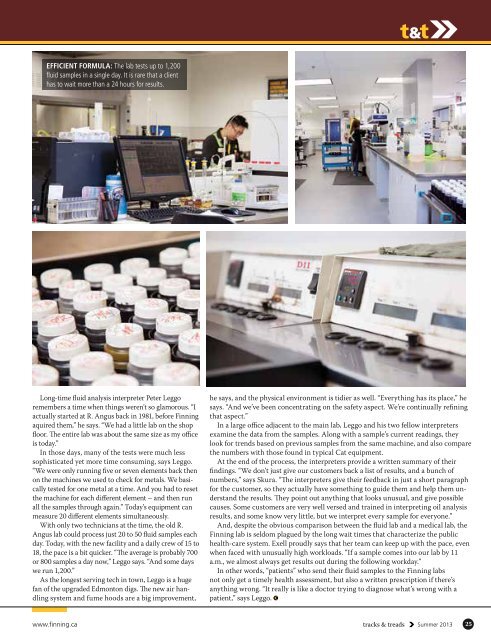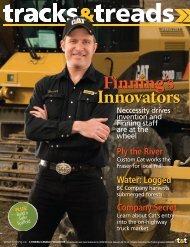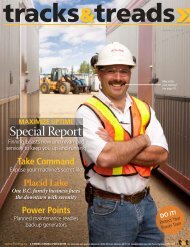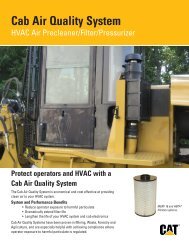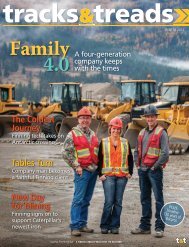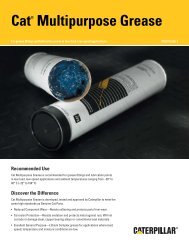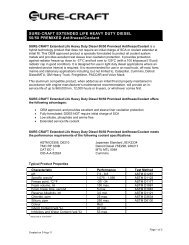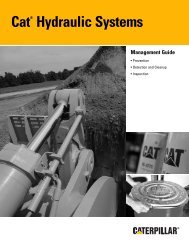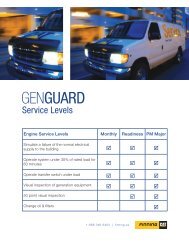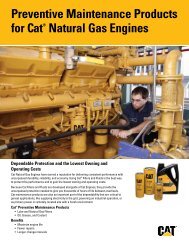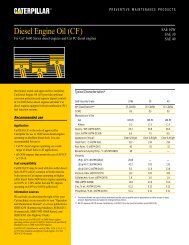Summer 2013 (4.43MB, PDF) - Finning Canada
Summer 2013 (4.43MB, PDF) - Finning Canada
Summer 2013 (4.43MB, PDF) - Finning Canada
- No tags were found...
You also want an ePaper? Increase the reach of your titles
YUMPU automatically turns print PDFs into web optimized ePapers that Google loves.
EFFICIENT FORMULA: The lab tests up to 1,200fluid samples in a single day. It is rare that a clienthas to wait more than a 24 hours for results.Long-time fluid analysis interpreter Peter Leggoremembers a time when things weren’t so glamorous. “Iactually started at R. Angus back in 1981, before <strong>Finning</strong>aquired them,” he says. “We had a little lab on the shopfloor. The entire lab was about the same size as my officeis today.”In those days, many of the tests were much lesssophisticated yet more time consuming, says Leggo.“We were only running five or seven elements back thenon the machines we used to check for metals. We basicallytested for one metal at a time. And you had to resetthe machine for each different element – and then runall the samples through again.” Today’s equipment canmeasure 20 different elements simultaneously.With only two technicians at the time, the old R.Angus lab could process just 20 to 50 fluid samples eachday. Today, with the new facility and a daily crew of 15 to18, the pace is a bit quicker. “The average is probably 700or 800 samples a day now,” Leggo says. “And some dayswe run 1,200.”As the longest serving tech in town, Leggo is a hugefan of the upgraded Edmonton digs. The new air handlingsystem and fume hoods are a big improvement,he says, and the physical environment is tidier as well. “Everything has its place,” hesays. “And we’ve been concentrating on the safety aspect. We’re continually refiningthat aspect.”In a large office adjacent to the main lab, Leggo and his two fellow interpretersexamine the data from the samples. Along with a sample’s current readings, theylook for trends based on previous samples from the same machine, and also comparethe numbers with those found in typical Cat equipment.At the end of the process, the interpreters provide a written summary of theirfindings. “We don’t just give our customers back a list of results, and a bunch ofnumbers,” says Skura. “The interpreters give their feedback in just a short paragraphfor the customer, so they actually have something to guide them and help them understandthe results. They point out anything that looks unusual, and give possiblecauses. Some customers are very well versed and trained in interpreting oil analysisresults, and some know very little, but we interpret every sample for everyone.”And, despite the obvious comparison between the fluid lab and a medical lab, the<strong>Finning</strong> lab is seldom plagued by the long wait times that characterize the publichealth-care system. Exell proudly says that her team can keep up with the pace, evenwhen faced with unusually high workloads. “If a sample comes into our lab by 11a.m., we almost always get results out during the following workday.”In other words, “patients” who send their fluid samples to the <strong>Finning</strong> labsnot only get a timely health assessment, but also a written prescription if there’sanything wrong. “It really is like a doctor trying to diagnose what’s wrong with apatient,” says Leggo.www.finning.ca <strong>Summer</strong> <strong>2013</strong> 25


